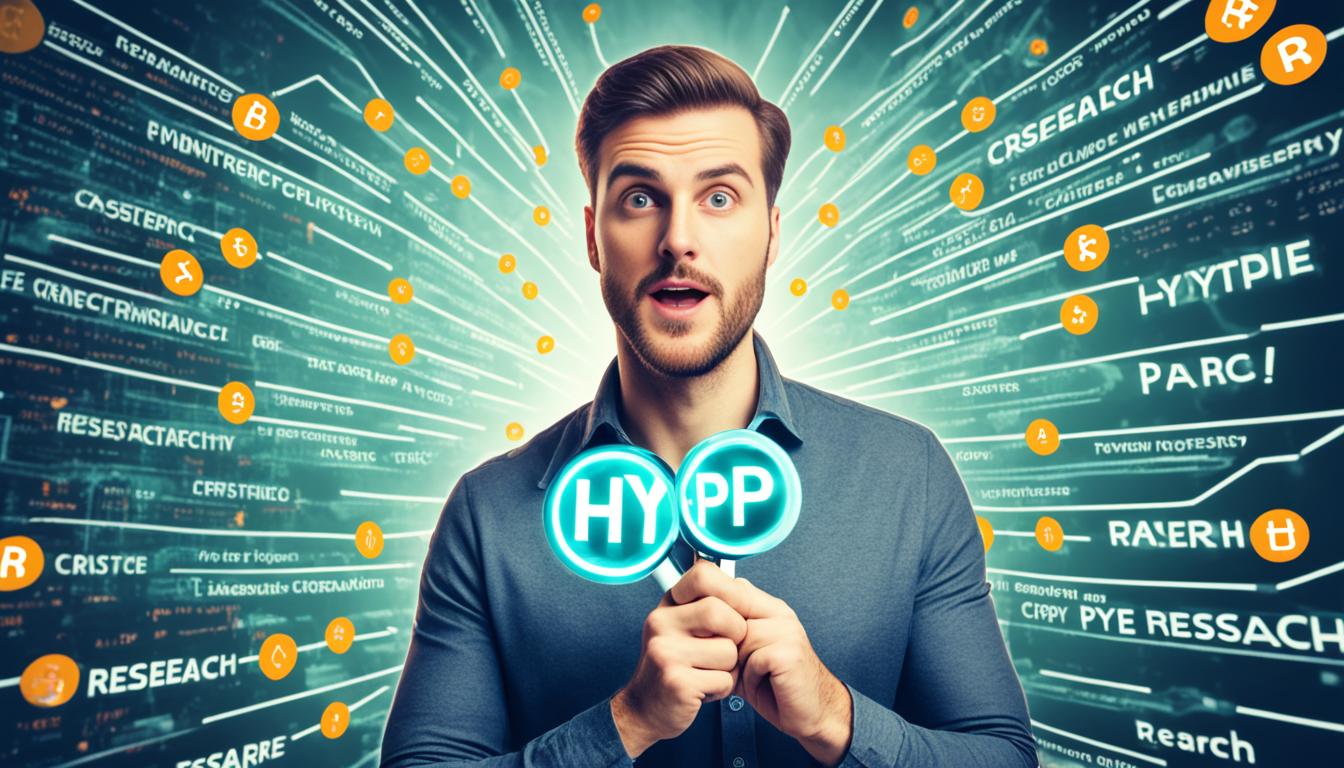Did you know that as of the close of 2023, over 10,000 cryptocurrencies were recorded in the digital market? Jumping into such a vast sea can be daunting for first-timers. Without the right guidance, you might find yourself adrift in a complex ocean of digital assets. This is why understanding the best cryptocurrencies for beginners is crucial to enter this revolutionary frontier. In your journey to getting started with cryptocurrency, certain digital currencies stand out for their robust fundamentals, stability, and user-friendly interfaces, making the daunting task of entry significantly less intimidating. Let’s navigate through the cryptocurrency basics for beginners, offering an introductory cryptocurrency course of sorts to the world’s innovative monetary system.
Starting with the essentials, beginner-friendly cryptocurrency tips include identifying names like Bitcoin and Ethereum—giants with high market capitalizations and proven track records. But beyond these household names exist a myriad of options with potent potential for beginners wanting to dip their toes into the digital waters. To assist novices in understanding this dynamic space, this article will provide beginner-friendly cryptocurrency information, specifically tailored to ease the initial plunge into crypto investments.
Contents
- 1 Understanding the Cryptocurrency Landscape
- 2 Cryptocurrency for Beginners
- 3 Key Players in the Crypto Market: A Review
- 4 Security and Self-Custody of Digital Assets
- 5 Top Selections for Crypto Beginners
- 6 Investment Strategies: Navigating the Market
- 7 Maximizing Returns: Staking and Trading
- 8 The Vision of Decentralized Finance (DeFi)
- 9 The Future of Cryptocurrency: Trends and Predictions
- 10 Building a Cryptocurrency Portfolio Step by Step
- 11 Conclusion
- 12 FAQ
- 12.1 What are the best cryptocurrencies for beginners in 2024?
- 12.2 What are the criteria for selecting beginner-friendly cryptocurrencies?
- 12.3 What are some low volatility cryptocurrencies suitable for beginners?
- 12.4 What are some introductory platforms for beginners to start their cryptocurrency investments?
- 12.5 What is Bitcoin (BTC) and why is it important for beginners to understand?
- 12.6 What is Ethereum (ETH) and why is it important for beginners to understand?
- 12.7 What are altcoins and stablecoins, and why are they relevant for beginners?
- 12.8 How can beginners secure their cryptocurrency holdings?
- 12.9 What are some top selections of cryptocurrencies for beginners?
- 12.10 What are some investment strategies beginners can employ in the cryptocurrency market?
- 12.11 How can beginners maximize their returns through staking and trading?
- 12.12 What is decentralized finance (DeFi) and why is it important for beginners to understand?
- 12.13 How is DeFi shaping financial transactions, and what are some applications and platforms beginners should be aware of?
- 12.14 What are some beginner-friendly DeFi platforms and protocols?
- 12.15 What are the future trends and predictions for the cryptocurrency market?
- 12.16 How can beginners build a cryptocurrency portfolio step by step?
Key Takeaways
- Embrace the expansive world of cryptocurrency by first understanding the market leaders and their significance for rookie investors.
- Discover cryptocurrencies with low volatility—ideal for beginners seeking stable entry points into the crypto space.
- Gain insight into beginner-friendly platforms that make initial investments less intimidating and more accessible.
- Equip yourself with reliable information on cryptocurrency basics needed to make informed decisions in the digital asset arena.
- Explore how a strategic choice of cryptocurrencies can be the first step in building a diversified and resilient investment portfolio.
Understanding the Cryptocurrency Landscape
As you embark on your journey into the realm of digital currency, gaining a solid understanding of the cryptocurrency market is essential. This knowledge base will not only inform your investment decisions but also provide you with insights into the wider financial implications of this transformative technology.
The basics of cryptocurrencies rest on blockchain technology, a decentralized ledger that records all transactions across a network of computers. This revolutionary technology ensures transparency, security, and immutability, which are critical features that distinguish cryptocurrencies from traditional fiat currencies.
An overview of the cryptocurrency landscape reveals a vibrant and diverse ecosystem with a myriad of digital tokens, each with unique functionalities and purposes. At the foundation of this ecosystem is Bitcoin, the original cryptocurrency, followed by Ethereum, known for its smart contracts, along with countless other altcoins.
For individuals new to this space, a beginner’s guide to the cryptocurrency market is an invaluable tool. It will walk you through the complexities of crypto exchanges, digital wallets, and the importance of private keys. With this guide, you will understand how to navigate the cryptocurrency market’s volatility and recognize investment opportunities.
The current state of the cryptocurrency market is dynamic, with new projects and technologies emerging at a rapid pace. Despite market fluctuations, the growth potential of cryptocurrencies remains significant. From enhancing cross-border transactions to enabling smart contracts that can revolutionize industries, cryptocurrencies continue to push the boundaries of what is possible within the digital economy.
In conclusion, whether you seek to diversify your investment portfolio, participate in groundbreaking blockchain projects, or simply learn about the future of money, understanding the cryptocurrency market lays the groundwork for informed participation in this digital frontier.
Cryptocurrency for Beginners
As you embark on your journey into the world of digital assets, it’s crucial to understand the features that constitute beginner-friendly cryptocurrencies. One needs to look beyond the buzz and delve into characteristics of beginner-friendly cryptos that ensure a smoother and more stable introduction to this dynamic market. Let us guide you through the essential criteria, notable stable cryptocurrencies for beginners, and the best platforms for beginners to invest in cryptocurrency—all designed to help you navigate the digital currency landscapes with confidence.
Criteria for Beginner-Friendly Cryptocurrencies
Entering the domain of cryptocurrencies requires a strategic approach, especially for novices. Looking for those with low entry barriers, these beginner-friendly cryptocurrencies offer a variety of attributes that make them suitable for those just starting out. The main characteristics of beginner-friendly cryptos include substantial market capitalization, indicating stability and lower risk, alongside high liquidity for easier trades. In addition, beginner-friendly low volatility cryptos present less drastic price fluctuations, contributing to a more predictable investment experience.
Exploring Low Volatility Crypto Assets
For beginners, navigating the turbulent waters of crypto investments can be daunting. Low volatility cryptocurrencies are akin to calm harbors offering respite from the storms. While no asset is entirely immune to market swings, stable cryptocurrencies for beginners boast reduced price variability, therefore, serving as a solid foundation for your first portfolio. Initiating your crypto journey with such assets can provide a gentler learning curve and a more forgiving environment for experimentation and growth.
Introductory Platforms for Crypto Investments
Selecting the right platform is as important as the asset itself. Beginner-friendly cryptocurrency platforms are distinguished by their user-centric approach, encompassing intuitive interfaces, comprehensive educational content, and supportive customer service. Introductory crypto investment platforms also prioritize security, ensuring your inaugural venture into the digital currency space is safeguarded. Opt for platforms known for their reliability and ease-of-use to build your investment skills on solid ground.
In the table below, we highlight the best platforms for beginners to invest in cryptocurrency, comparing their key features to help you make an informed choice:
| Platform | User-Friendliness | Education Resources | Security Measures | Customer Support |
|---|---|---|---|---|
| Coinbase | Highly intuitive UI | Extensive guides and tutorials | 2FA, Insurance | 24/7 Support Center |
| Binance | Easy navigation | Detailed articles and videos | Advanced security tech | Multi-language support |
| eToro | User-friendly platform | Trading academy | FDIC insured | Dedicated help center |
| Kraken | Simplified design for starters | Informative blog and guide | Rigorous security standards | 24/7 live chat and email |
When choosing a platform, weigh each option against these factors to determine the most beginner-friendly cryptocurrency platform for your entry into the market. The ideal choice will depend on your personal preferences, but always put security and educational support as top priorities.
Key Players in the Crypto Market: A Review
As you venture into the world of cryptocurrencies, it’s essential to familiarize yourself with the market’s key players. Understanding the fundamentals of top cryptocurrencies like Bitcoin (BTC) and Ethereum (ETH), as well as the various altcoins and stablecoins, can provide a solid foundation for investing in crypto for beginners. Let’s delve deeper into these essential pillars of the digital currency market.
Bitcoin (BTC): The Pioneer Crypto
Bitcoin, the first cryptocurrency ever created, remains the most recognized and influential player in the market. As you begin your journey, a beginner’s guide to Bitcoin will show you the ropes, teaching you Bitcoin basics such as blockchain technology, mining, and secure transactions. BTC not only paved the way for other digital currencies but also continues to be a staple for anyone investing in Bitcoin for beginners.
Ethereum (ETH): Foundation of Decentralized Applications
Following in the steps of Bitcoin, Ethereum brought forth innovative concepts to the crypto space. A beginner’s guide to Ethereum will illuminate the Ethereum basics, including its role in enabling smart contracts and fostering the creation of decentralized applications (dApps). ETH has been foundational to the blockchain’s growth, expanding the possibilities for startups and established businesses alike, and thus plays a crucial part when investing in Ethereum for beginners.
The Role of Altcoins and Stablecoins
Altcoins and stablecoins represent the diversity of the cryptocurrency market. A beginner’s guide to altcoins will introduce you to the plethora of options available beyond BTC and ETH. These cryptocurrencies often aim to address specific use cases or improve upon the shortcomings of their larger counterparts. While altcoins bring innovation and variety, a beginner’s guide to stablecoins is vital in understanding cryptocurrencies pegged to traditional assets, providing a more stable investment option for the risk-averse. Educating yourself on investing in altcoins and stablecoins for beginners often means a more diversified and robust investment strategy.
As the crypto universe evolves, it’s important for new investors to gain clarity on the significance of these cryptocurrencies. Whether it be Bitcoin, the gold standard of digital assets, or Ethereum as a platform for decentralization, or the wide array of altcoins and the security of stablecoins, understanding their individual roles can make investing in Bitcoin for beginners or investing in Ethereum for beginners a more confident endeavor.
The cryptocurrency market is dynamic and seems to always be in flux. Deciphering Bitcoin basics or Ethereum basics is not just about the how and why; it’s about seeing the potential these technologies bring to the future financial systems. Whether you’re looking at the investment potential of BTC and ETH or exploring the utility of various altcoins and stablecoins, this beginner’s guide to Bitcoin, alongside other digital currencies, sets you on a path that could redefine your approach to personal investment and wealth management.
| Cryptocurrency | Main Features | Benefits for Beginners |
|---|---|---|
| Bitcoin (BTC) | First decentralized digital currency, limited supply, widespread adoption | Proven track record, high liquidity, significant community and developer support |
| Ethereum (ETH) | Smart contracts, decentralized applications, transition to proof-of-stake | Investment in a growing ecosystem, potential gains from dApps and DeFi |
| Altcoins | Specialized use cases, varied technologies and consensus mechanisms | Opportunities for niche investments, potential for high returns on emerging tech |
| Stablecoins | Pegged to fiat currencies or commodities, lower volatility | Reduced risk, suitable for diversification and as a hedge against volatility |
Security and Self-Custody of Digital Assets
As you venture into the world of cryptocurrencies, understanding and implementing cryptocurrency security is not just recommended but essential. When it comes to the self-custody of digital assets, there’s no room for error. Self-custody means that only you have access to your private keys—and this power comes with significant responsibility. Think of it as being your own bank, where protecting your assets is paramount.
For those just starting, a beginner’s guide to securing crypto assets can be invaluable in navigating this terrain. With diverse threats ranging from hackers to software vulnerabilities, it’s critical to follow the best practices for cryptocurrency security. Here are some key elements to consider for safeguarding your investments.
- Passwords and Authentication: Use complex, unique passwords for every account and enable two-factor authentication whenever possible.
- Secure Storage: Research and utilize hardware wallets or reputable digital wallet services with a strong track record of security.
- Regular Updates: Ensure all your software is up-to-date, including wallet software and antivirus protection to guard against malware.
- Network Security: Be cautious of public Wi-Fi networks when accessing or transacting with your assets. Consider the use of VPNs.
| Security Feature | Description | Benefit |
|---|---|---|
| Encryption | Encrypting wallet data and backup seeds. | Keeps data unreadable to unauthorized parties. |
| Multi-Signature Support | Multiple private keys to authorize a crypto transaction. | Adds a layer of security, as one key alone is not enough to access funds. |
| Regular Backups | Frequent backing up of wallet information. | Protects against accidental losses due to hardware failure or human error. |
| Hardware Wallets | Physical devices that store crypto offline. | Immune to online hacking attempts. |
Remember, the goal is to minimize vulnerabilities and secure your future in this digital landscape. Educating yourself on cryptocurrency security is the first step to ensuring that your journey is not only exciting but also safe. By taking personal responsibility and practicing self-custody of digital assets, you set a foundation for long-term success in the cryptocurrency market.
Top Selections for Crypto Beginners
Embarking on the journey of cryptocurrency investment can be daunting for newcomers. It’s essential to navigate this innovative landscape with knowledge about top cryptocurrencies for beginners. This careful curation of beginner-friendly crypto picks is designed to aid you in making informed decisions while entering the world of digital assets. The selections listed here take into account the vital features you should look for, such as market capitalization, historical performance, ease of acquisition, and potential for growth—making them some of the best cryptos for newbie investors.
When considering where to allocate your initial investment, the enormity of choices can be overwhelming. Below is an insightful table that compares several cryptocurrencies that have proven to be suitable for those with limited experience in the market. These assets have been chosen for their robust foundations, wider acceptability, and stronger governance models. Take a look to understand how each cryptocurrency stacks up in terms of beginner-friendliness and investment potential.
| Cryptocurrency | Market Capitalization | Key Features | Ease of Use | Potential Returns |
|---|---|---|---|---|
| Bitcoin (BTC) | $XXX Billion | Widely recognized, High liquidity | High | Stable growth over long term |
| Ethereum (ETH) | $XXX Billion | Smart contracts, Large developer community | High | Significant with network upgrades |
| Litecoin (LTC) | $XX Billion | Faster transactions, Low fees | Moderate | Moderate, with steady adoption |
| Cardano (ADA) | $XX Billion | Sustainability-focused, Research-driven | High | High, if development goals are met |
| Binance Coin (BNB) | $XX Billion | Utility token, Reduced trading fees | High | Dependent on platform success |
As you delve into your investment journey, bear in mind that the realm of cryptocurrencies is ever-evolving. What may be considered the best cryptos for newbie investors today could shift as the market matures and new technologies emerge. To stay ahead, remain educated, and continue to seek out the most current and beginner-friendly options. Start with these recommendations and grow your portfolio from a solid foundation of sound, beginner-friendly cryptocurrency choices.
Embarking on the journey of cryptocurrency investment strategies can be thrilling yet complex for newcomers. Understanding the distinction between long-term vs. short-term crypto investing is crucial for your success in this volatile digital financial arena.
As you delve into the beginner’s guide to crypto investments, it’s important to recognize that long-term investing often involves holding assets for years, capitalizing on the potential for gradual growth and minimizing exposure to short-term market fluctuations. Alternatively, short-term investing leverages these fluctuations in an attempt to turn swift profits, though this approach carries greater risk and requires keen market insight.
- Hedge against market volatility by diversifying your portfolio.
- Research extensively both the currencies and the market trends.
- Set clear investment goals aligned with your risk tolerance.
The foundation of sound cryptocurrency investment strategies includes a well-informed decision-making process. This not only involves understanding the technical analysis of price movements but also staying updated with industry developments that could impact the market. Whether you opt for long-term gains with mitigated risk or shorter, more speculative moves, your methodology should always prioritize informed choices and judicious risk management.
Moreover, consider utilizing tools and insights from reputable sources to refine your investment approach. Utilizing historical data, market sentiment analysis, and future projections can enhance the strategic component of your crypto endeavors. Remember, there’s no one-size-fits-all strategy in cryptocurrency investment – it’s about forging a path that aligns with your investment goals and comfort level with market volatility.
To solidify your knowledge, seek out community discussions and expert insights that can guide you towards making informed decisions. Keep in mind, the ever-evolving nature of digital currencies demands an agile and proactive approach to investment. As you grow more confident and well-versed in market intricacies, your ability to navigate the volatile waters of cryptocurrency will invariably improve.
Maximizing Returns: Staking and Trading
Embarking on cryptocurrency trading can be an exhilarating journey for newcomers, offering a dynamic realm filled with potential returns. For the uninitiated, embracing a beginner’s guide to staking and trading becomes instrumental in navigating this volatile market. Here, you’ll acquire the acumen to leverage market trends and capitalize on the mechanisms inherent to cryptocurrencies for maximizing crypto returns.
Cryptocurrency staking, a term you’ll often encounter, is essentially a method to earn rewards by holding certain cryptocurrencies. It provides a two-fold benefit: securing the network and verifying transactions. For beginners interested in a more passive approach, staking stands out as a viable option. It requires less active management than trading and can generate a steady return on investment over time.
Contrastingly, cryptocurrency trading demands a more hands-on and vigilant approach. It involves analyzing market movements and executing trades to profit from price fluctuations. Those with a keen eye for detail and the discipline to adhere to trading strategies can thrive, especially when engaging with well-informed decisions.
For those eager to delve into the details, consider the following table which juxtaposes the fundamental aspects of staking and trading:
| Aspect | Cryptocurrency Staking | Cryptocurrency Trading |
|---|---|---|
| Engagement Level | Low – Set up and revisit periodically | High – Requires regular monitoring |
| Risk Profile | Generally lower risk, stable returns | Higher risk, potentially higher rewards |
| Profit Generation | Through rewards and incentives | Through asset price appreciation |
| Market Knowledge | Basic understanding of staking mechanisms | In-depth market analysis and strategy |
| Liquidity | Typically reduced due to lock-up periods | Higher due to active trading |
| Suitable For | Investors seeking passive income | Active traders looking for quick gains |
Whether you lean towards the steady course of staking or the agile seas of trading, remember the importance of research. Equip yourself with knowledge and tools to craft a strategy that aligns with your financial goals and risk tolerance. As a fledgling participant in the crypto domain, prudence paired with informed action paves the path to potential profitability and growth.
The Vision of Decentralized Finance (DeFi)
Embarking on the journey to understand decentralized finance, commonly known as DeFi, is like uncovering a new horizon in the financial landscape. This transformative sector within the cryptocurrency market is not just a buzzword; it’s a substantial move towards a more open, accessible financial world for everyone, including you who might just be starting out. The importance of DeFi lies in its core principles—eliminating the middlemen and giving users full control over their financial transactions.
Understanding DeFi and Its Importance
For a beginner’s guide to DeFi, think of it as a comprehensive ecosystem of financial applications and services built on blockchain technology, specifically designed to operate autonomously without the need for traditional financial intermediaries like banks, insurers, or clearinghouses. Decentralized finance presents an array of DeFi applications that facilitate everything from lending and borrowing to trading and investment, all with a transparent and permissionless nature.
How DeFi is Shaping Financial Transactions
DeFi and financial transactions are now closely intertwined, seeing a paradigm shift in how people view money and assets. With the help of DeFi platforms, services like peer-to-peer lending, decentralized exchanges, and asset management have become accessible to any user with an internet connection, bypassing geographical restrictions and reducing costs associated with legacy financial systems.
Beginner-Friendly DeFi Platforms and Protocols
Finding beginner-friendly DeFi platforms is essential for newcomers delving into this complex world. The best DeFi platforms for beginners offer user-friendly interfaces, robust instructional content, and communities willing to assist new participants. These beginner-friendly DeFi protocols are designed to reduce the steep learning curve typically associated with blockchain-related technologies.
| DeFi Platform | Services Offered | Notable Features | User Experience Level |
|---|---|---|---|
| Uniswap | Token Swaps, Liquidity Provision | Automated Market Maker, No Order Book | Beginner to Intermediate |
| Compound | Lending, Borrowing | Algorithmic Interest Rates | Beginner to Advanced |
| Aave | Lending, Borrowing, Yield Farming | Flash Loans, Rate Switching | Intermediate to Advanced |
| MakerDAO | Stablecoin Issuance, Collateralized Loans | DAI Stablecoin, Governance | Intermediate |
As you explore these beginner-friendly DeFi protocols, remember to perform due diligence and become comfortable with the fundamental aspects of using blockchain-based services. Decentralized finance is rapidly changing, and while it promises significant innovations, knowledge and caution are your keys to navigating this space successfully.
Embrace the vision of DeFi as it ushers in a future where financial power is redistributed and democratized. It’s more than an investment opportunity; it’s a shift towards a more inclusive financial system. As you embark on this beginner’s guide to DeFi applications, know that you are at the forefront of shaping the future of finance.
The Future of Cryptocurrency: Trends and Predictions
As you embark on your cryptocurrency journey, it’s crucial to look ahead and consider where is cryptocurrency headed. Engaging with the future of cryptocurrency is not just about understanding the current landscape but about anticipating the changes on the horizon. Peer closely into the crystalline sphere of cryptocurrency predictions, where pulsating trends promise to sculpt a new reality for investors and participants alike.
Cryptocurrency trends suggest a propulsion toward more mainstream adoption, where tokens morph from esoteric assets to commonplace financial tools. Consider the augmented push towards scalability and sustainability, the two beacons guiding digital currency’s voyage. These elements are set to further entrench blockchain technologies into our daily transactions, ultimately rendering them as habitual as the credit cards we swipe.
In the tableau of cryptocurrency predictions, security is painted with broad and heavy strokes. Expect innovations in regulatory frameworks, fostering a balanced milieu where protection weds freedom. Enhanced security measures and regulatory clarity could play pivotal roles in investor confidence, potentially leading to increased market stability.
The tapestry of cryptocurrency predictions is also woven with threads of technological advancements. The evolution of smart contracts, layer-2 solutions, and cross-chain interoperability are anticipated to keep knitting the fabric more tightly. These advancements could streamline transactions, decrease fees, bolster speed, and, dare one say, weave a new era of user experience that speaks both of efficiency and delight.
Lastly, turning pages in the annals of where is cryptocurrency headed, decentralized finance (DeFi) and non-fungible tokens (NFTs) scribe their chapters robustly. These sectors are forecasted to surge, potentially redefining the paradigms of trade, art, and ownership. You may witness the democratization of finance, where DeFi extends its tendrils into the soil of society, enriching those who’ve yet to taste the fruits of traditional banking sectors.
Whether these predictions unfurl as foretold, or the odyssey takes unforeseen turns, you stand on the precipice of a fascinating continuum. The amalgam of knowledge and foresight will be your compass in this exhilarating expedition toward the promising yet unpredictable destiny of cryptocurrency.
Building a Cryptocurrency Portfolio Step by Step
Embarking on the journey of building a cryptocurrency portfolio can be an exhilarating yet complex process, especially for those new to the digital asset space. Whether you’re looking to grasp the essentials of a beginner’s guide to building a crypto portfolio, or eager to understand the critical steps to build a crypto portfolio, this section is tailored to facilitate your navigation through the fledgling world of cryptocurrencies.
A diversified portfolio is your strongest defense against the market’s inherent unpredictability. Prioritizing asset allocation allows you to balance potential risks and rewards. Cryptocurrency, with its rapid growth, stands out as an attractive, yet volatile market. That’s why learning the right strategies is crucial to maintaining a resilient investment mix.
- Assessment of Your Risk Tolerance: Begin by evaluating your comfort level with risk. This will shape the types of cryptocurrencies and the percentage of your portfolio they will represent.
- Research is Key: Conduct thorough research on various coins and tokens, understanding their market position, technology, and long-term vision.
- Start with Major Cryptocurrencies: Consider starting with well-established cryptocurrencies as they often provide a stable foundation.
- Diversification: Diversify your portfolio with a mix of different coins, thinking beyond just Bitcoin and Ethereum to include altcoins and tokens that serve various niches.
- Investment Sizing: Decide on how much to invest in each asset. A balanced approach is paramount to managing potential downturns in any one investment.
A pivotal element in crafting your portfolio is periodic evaluation and rebalancing. As the market shifts, so should your investments, to remain aligned with your financial goals. Now, let’s visually break down what an initial crypto portfolio could look like for a beginner investor:
| Cryptocurrency | Market Cap Rank | Investment (%) | Notes |
|---|---|---|---|
| Bitcoin (BTC) | 1 | 40% | Leading digital currency, high liquidity |
| Ethereum (ETH) | 2 | 25% | Powerful smart contract platform |
| Binance Coin (BNB) | 3 | 10% | Exchange-based token with utility |
| Cardano (ADA) | 6 | 10% | Promising research-based smart contract platform |
| Chainlink (LINK) | 15 | 5% | Decentralized oracle network |
| Polkadot (DOT) | 8 | 5% | Interoperability protocol |
| Stablecoins (USDT/USDC) | Varies | 5% | Lower volatility, good for liquidity |
Finally, remember that a key facet of a beginner’s guide to building a crypto portfolio is continuous learning and staying updated on market trends. Engage with community discussions, follow industry news, and consider obtaining insights from trusted financial advisors who specialize in cryptocurrencies.
By taking progressive steps to build a crypto portfolio, you’ll cultivate the knowledge and develop the expertise required for creating a robust investment strategy. Whether you aim to capitalize on the volatility for short-term gains or build a portfolio for the distant future, starting with these foundational steps will position you to harness the potential of the cryptocurrency market.
Conclusion
As you stand at the threshold of the dynamic world of digital assets, the journey across the cryptocurrency landscape can seem daunting, yet exhilarating. We have traversed the essential aspects, from understanding the very fabric of the cryptocurrency market to highlighting the foundational players like Bitcoin and Ethereum. Navigating through security protocols, diving into investment strategies, and unraveling the potential of DeFi, this guide has aimed to arm you with the foundational knowledge to tackle the crypto sphere with confidence.
Indubitably, the adoption of cryptocurrencies is accelerating, and the need for a pragmatic approach to these virtual assets is pivotal. Your first step into the arena should be marked by cautious optimism and a stern commitment to continuous learning. The final thoughts on cryptocurrency for beginners emphasize the value of patience and due diligence. Begin with a stronghold on the basics, diversify wisely and don’t discount the benefits of secure and responsible investing practices.
In closing, remember that cryptocurrencies are more than a financial fad; they represent a paradigm shift in the way we perceive value and conduct transactions. The technologies underlying these assets have the potential to redefine the boundaries of our economic systems. As the cryptocurrency market continues to evolve, keep abreast of the trends and stay grounded in the strategies that prioritize safeguarding your investments. The conclusion of this article marks the commencement of your well-informed crypto journey, leading towards what may be the most vibrant era of digital finance.
FAQ
What are the best cryptocurrencies for beginners in 2024?
The best cryptocurrencies for beginners in 2024 are those that possess low volatility, high market capitalization, and are user-friendly. Some examples include Bitcoin (BTC), Ethereum (ETH), and stablecoins like Tether (USDT).
What are the criteria for selecting beginner-friendly cryptocurrencies?
Beginner-friendly cryptocurrencies should have low volatility, substantial market capitalization, and a high level of user-friendliness. These criteria ensure a more stable investment and a better user experience for beginners.
What are some low volatility cryptocurrencies suitable for beginners?
Some low volatility cryptocurrencies suitable for beginners are stablecoins like Tether (USDT), USD Coin (USDC), and Binance USD (BUSD).
What are some introductory platforms for beginners to start their cryptocurrency investments?
Some beginner-friendly platforms for cryptocurrency investments include Coinbase, Binance, and Kraken. These platforms provide easy account setup, secure storage, and educational resources to help beginners get started.
What is Bitcoin (BTC) and why is it important for beginners to understand?
Bitcoin (BTC) is the pioneer cryptocurrency and the most well-known digital asset. It’s important for beginners to understand Bitcoin because it serves as a foundation for the entire cryptocurrency market and has significant investment potential.
What is Ethereum (ETH) and why is it important for beginners to understand?
Ethereum (ETH) is a blockchain platform that enables the development of decentralized applications (dApps) and smart contracts. It’s important for beginners to understand Ethereum because it has the potential to revolutionize various industries and offers unique features for developers.
What are altcoins and stablecoins, and why are they relevant for beginners?
Altcoins are any cryptocurrencies other than Bitcoin, and stablecoins are cryptocurrencies designed to maintain a stable value. These types of digital assets are relevant for beginners because they offer additional investment options and potential benefits such as reduced volatility.
How can beginners secure their cryptocurrency holdings?
To secure their cryptocurrency holdings, beginners should follow best practices such as using hardware wallets, enabling two-factor authentication, and keeping their private keys offline. It’s important to prioritize security to protect investments from potential threats.
What are some top selections of cryptocurrencies for beginners?
Some top selections of cryptocurrencies for beginners include Bitcoin (BTC), Ethereum (ETH), and Litecoin (LTC). These cryptocurrencies have substantial market capitalization, strong investment potential, and are relatively user-friendly.
What are some investment strategies beginners can employ in the cryptocurrency market?
Beginners can consider both long-term and short-term investment strategies in the cryptocurrency market. Long-term strategies involve holding cryptocurrencies for an extended period, while short-term strategies focus on taking advantage of price fluctuations for quick profits.
How can beginners maximize their returns through staking and trading?
Beginners can maximize their returns in the cryptocurrency market by participating in staking, which involves earning passive income by holding and validating certain cryptocurrencies. Trading, on the other hand, involves actively buying and selling cryptocurrencies to take advantage of price movements.
What is decentralized finance (DeFi) and why is it important for beginners to understand?
Decentralized finance (DeFi) refers to the use of blockchain technology to provide traditional financial services in a decentralized manner. It’s important for beginners to understand DeFi because it offers innovative and accessible financial solutions that can potentially disrupt traditional systems.
How is DeFi shaping financial transactions, and what are some applications and platforms beginners should be aware of?
DeFi is shaping financial transactions by enabling peer-to-peer lending, decentralized exchanges, and other financial services without intermediaries. Some popular DeFi applications and platforms include Compound, Uniswap, and Aave, which provide various opportunities for users to participate in the DeFi ecosystem.
What are some beginner-friendly DeFi platforms and protocols?
Beginner-friendly DeFi platforms and protocols include MetaMask, yearn.finance, and SushiSwap. These platforms offer a user-friendly experience and allow beginners to easily participate in the DeFi ecosystem.
What are the future trends and predictions for the cryptocurrency market?
The future of the cryptocurrency market is characterized by emerging technologies such as decentralized finance, non-fungible tokens (NFTs), and increased adoption by institutional investors. The market is expected to continue growing, offering both opportunities and challenges for participants.
How can beginners build a cryptocurrency portfolio step by step?
Beginners can build a cryptocurrency portfolio by considering factors such as diversification, risk management, and regular portfolio rebalancing. It’s important to carefully select a range of cryptocurrencies and allocate investments based on individual risk tolerance and investment goals.








Leave a Reply